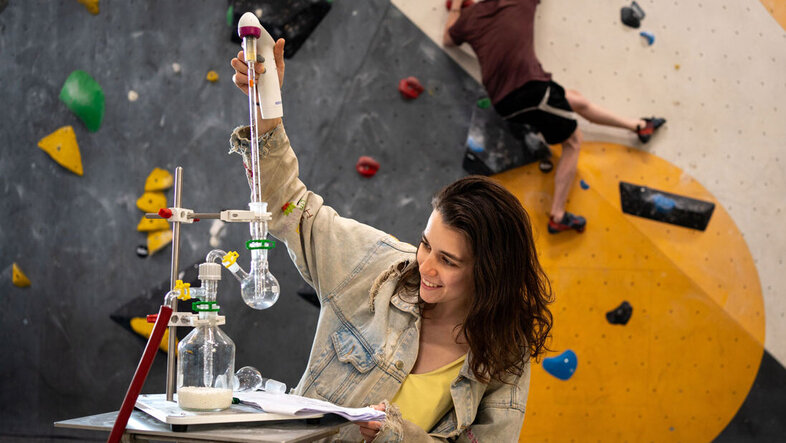The invisible health concern of indoor climbing
Upon entering an indoor climbing gym, you may immediately sense the smells of chalk dust, sweat – and a hint of rubber. Environmental scientists from Vienna and Lausanne, Switzerland, now discovered that rubber abrasion from climbing shoes can enter the human lung. The rubber contains chemical additives suspected of being harmful to people and the environment. In some cases, the measured concentration of these airborne chemicals was as high as by a busy urban road.
"The soles of climbing shoes are high-performance products, just like car tyres", explains Anya Sherman from the Centre for Microbiology and Environmental Systems Science (CeMESS) at the University of Vienna. In her PhD project in the research group led by Thilo Hofmann, Sherman studied the impact of tyre wear particles on people and the environment.
"As a rock climber myself, I started wondering whether the same chemical additives that make car tyres flexible and durable are also present in climbing shoes", says Sherman. At a conference, she met Thibault Masset from the École Polytechnique Fédérale de Lausanne (EPFL), who works on similar topics and also enjoys climbing. The two researchers, who are equal first authors of the study, decided to test the rubber from their own climbing shoes using the same methods they use to analyse car tyres. "We were familiar with the black residue on the holds in climbing gyms, the abrasion from the soles of our shoes. Climbers wipe it off to get a better grip, and it gets kicked up into the air", explains Sherman.
In 30 pairs of shoes tested, the team found rubber compounds similar to those used in car tyres - including additives suspected of being harmful to humans and the environment. Among the 15 additives found was 6PPD, a rubber stabiliser whose transformation product has been linked to salmon kills in rivers.
In collaboration with the research group of Lea Ann Daily from the Division of Pharmaceutical Technology and Biopharmaceutics, and equipped with a particle-measuring device that mimics the human respiratory tract, Sherman collected air samples in five bouldering gyms in Vienna. Her collaborators from Switzerland collected dust samples from gyms in France, Spain and Switzerland.
The researchers were startled by the concentration of rubber additives in the air, which was particularly high where many people were climbing in confined spaces: "Air pollution in the bouldering gyms was higher than we expected", says group leader Thilo Hofmann. "The levels we measured are among the highest ever documented worldwide, comparable to multi-lane roads in megacities."
While the project did not address what this means for human health, the researchers stress the need for countermeasures: "It makes sense to act before we know all the details about the risks, especially with regard to sensitive groups such as children", explains Hofmann. Shoe manufacturers should switch to sole materials with fewer harmful substances, while indoor climbing operators could improve air quality by better ventilation, cleaning and avoiding peak times. Sherman notes that the operators of the studied bouldering gyms were very cooperative and interested in improving air quality. "I am confident that our research will contribute to better conditions in climbing gyms – and I will continue to climb."
About the study
- The study "The Invisible Footprint of Climbing Shoes: High Exposure to Rubber Additives in Indoor Facilities" by Sherman et al. was published in "Environmental Science and Technology Air".
- Press release by the University of Vienna
Together with Sabine Pahl, he is heading the new Environment and Climate Research Hub.

